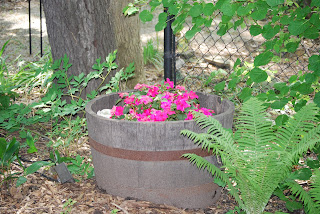It was great while it lasted. Impatiens filled even the shadiest garden from stem to stern with hot pinks, corals, salmon, fuschia and lovely lipstick red. No plucking nor cutting back, just simply add water. By August the blooms would merge, creating mounds of deep color, highly visible from anywhere in the yard. Downy mildew or impatient blight changed that.
Yet, as in life, adaptation is the key to good gardening.
 For deep shade, there truly are no replacements as colorful as impatiens, so it may be time for an interim detour to mainstay perennials like hosta, perhaps layered with spring bulbs.
For deep shade, there truly are no replacements as colorful as impatiens, so it may be time for an interim detour to mainstay perennials like hosta, perhaps layered with spring bulbs. Prefer annuals? Consider these:
 |
| White Sunpatiens |
2. Minmulus/Monkey Flower: With small blooms that resemble a monkey's face, these shade plants can't be found at a big box store, so stick with the local greenhouse. Block's Market Stand usually carries them, but their homegrown crop is limited. Monkey flowers will not pack the colorful punch of impatiens, but they'll provide delicate hues.
.JPG) 3. Coleus: Eh, unsure. The gardener looking for the same pop of primary color might not be amenable to the jewel toned rusts, browns, golds and greens of coleus. Plus, there must be much pinching back to maintain the mounding nature of a true border plant.
3. Coleus: Eh, unsure. The gardener looking for the same pop of primary color might not be amenable to the jewel toned rusts, browns, golds and greens of coleus. Plus, there must be much pinching back to maintain the mounding nature of a true border plant. 4. Begonia: A second cousin of impatiens, begonia colors are more limited. The smaller blooms and
cooler hues create a different effect, but the foliage is more interesting. My mother loved her red begonias. Not nearly as pest resistant as impatiens, yet these old girls may have the last laugh!
 |
| Sunpatiens and Alyssum as border plants |
Uncovering a scarce flat of impatiens, does one dare take the chance? Be judicious. Don't fill the yard with these risky blooms, but perhaps gamble with a flat of locally grown. Plant in a part shade location that did not host impatiens last year. Don't oversaturate, and irrigate in the morning to allow drying time. Avoid crowding and allow air circulation. Then, cross your fingers.
Possibly a benefit of the long cold winter may be the death of last year's downy mildew spores. Time will tell.
Enjoy and experiment with the alternatives. Ever changing borders are a gardener's happy challenge.
 More Articles of Interest:
More Articles of Interest:Layered Planting -- Should I Cut Back Faded Bulbs?
Impatiens Disease -- Trouble in the Landscape
When Should I Plant Annuals in Michigan?



Thank you for this very helpful advice. I am going to miss my impatiens.
ReplyDeleteWent looking for impatiens today and was told about the blight. Woman at the shop suggested New Guinea Impatiens instead (divine violet). Hope they work out well.
ReplyDelete